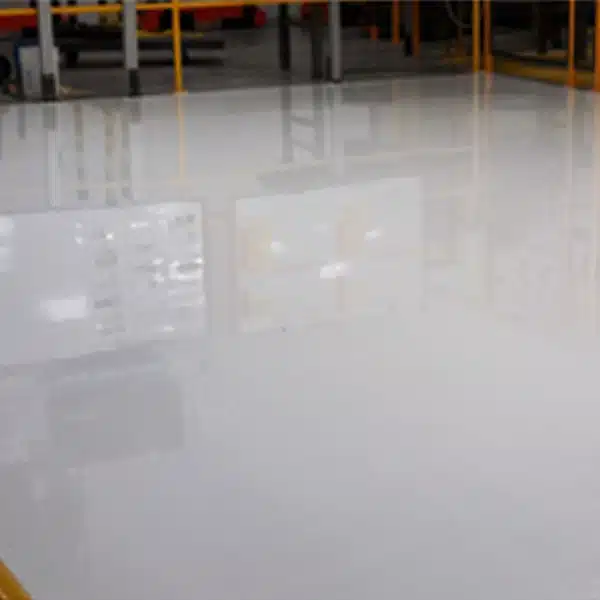
EPOXY POLY SOLID COLOR
A solid color system with our tried and true 100% solids epoxy, Epoxy Flow 100 as a base coat, and UV-stable Poly 90/85 as a topcoat. Creating a thicker, smoother floor. Available in slow set options for extended work times during installation.
EPOXY POLY SOLID COLOR SYSTEM BENEFITS AND CHARACTERISTICS

- Basecoat Epoxy Flow 100 (reg or slow) @ 150 sqft/gal
- Topcoat = Poly 90/85 Slow @ 250 sqft/gal
Step-by-Step Installation of Epoxy Poly Solid Color Instructions
Pre-Application Assessment & Preparation
- PREP: One of the key components is to ensure that the surface is free from sealers, dirt, oils, glues, and other contaminants. It also needs a profile.
- Do all repairs before grinding so repairs are ground flush with the floor. We recommend our Instant Medic Hard for all repairs for this coating system.
Methods for properly preparing the concrete are:
-
- Using a lower grit (16, 30) metal bond diamond tool on a single headed or planetary grinder with a vacuum and grinding dry
- Vacuum floor clean. Remove any other residual dust by leaf blowing and/or microfiber wiping. Do not use water
- You are going for a floor with a light broom finish like profile that is completely profiled, bone dry, and free of contaminants
- Using a lower grit (16, 30) metal bond diamond tool on a single headed or planetary grinder with a vacuum and grinding dry
2. Apply Epoxy Flow 100 pigmented(reg or slow): Mix Epoxy Flow 100 by drill mixing. Mix in the proper amount of pigment (1 pigment/3 gallons of Epoxy Flow 100).
Apply Epoxy Flow 100 to the floor by pouring the Epoxy on the floor and using a notched squeegee to spread the product and immediately backroll with an 18” , ⅜” nap roller cover. (Epoxy Flow 100 hangs out better on the floor than in the bucket. Don’t let the epoxy dwell in the bucket as this will expedite the set time) Coverage rates are approximately 100 sq ft per gallon.(Slow version will give longer times. All times are greatly effected by temperature). Refer to data sheet for more information.
3. Top Coat – Poly 90 or 85 Slow pigmented: Apply the top coat after the base coat has sufficiently set and is no longer tack free (Note this is greatly affected by temperature. Refer to data sheet of Epoxy for recoat window)
-
- Mix the Poly by drill mixing. (1:1) ratio
- Mix in the proper amount of pigment (1 Poly Pigment per 4 gallons of Poly 90/85 Slow).
- Poly colored topcoat should be applied by pouring the product on the floor and using a flat or small notch (5-7 mil) squeegee and immediately back rolling with a ⅜” nap, 18” roller. Top coats tend to lay out better with less chance of roller lines when using a squeegee and back rolling. Approximate coverage with this method is 250-300 sqft per gallon
- Poly 90/85 Slow hangs out in the bucket better than on the floor. Only apply the amount of product that can be effectively squeegeed and backrolled adequately at a time.
- Add traction additive if desired when mixing.
- Protect area from traffic until the coating has sufficiently dried (refer to data sheet and take temp. Into consideration)
INSTRUCTIONS
TECH SHEETS
Please Read: We do not sell the ‘finished floor’. You are responsible for creating the finished product. Please contact us with any questions. Mock ups are encouraged before doing your project. The information supplied by Concrete Floor Supply about our products and uses is not a representation or a warranty. It is supplied on the condition that you will make your own tests to determine the suitability of the product for your own particular purpose. Any use or application is the sole responsibility of the user. Listed physical properties are typical and should not be construed as specifications
